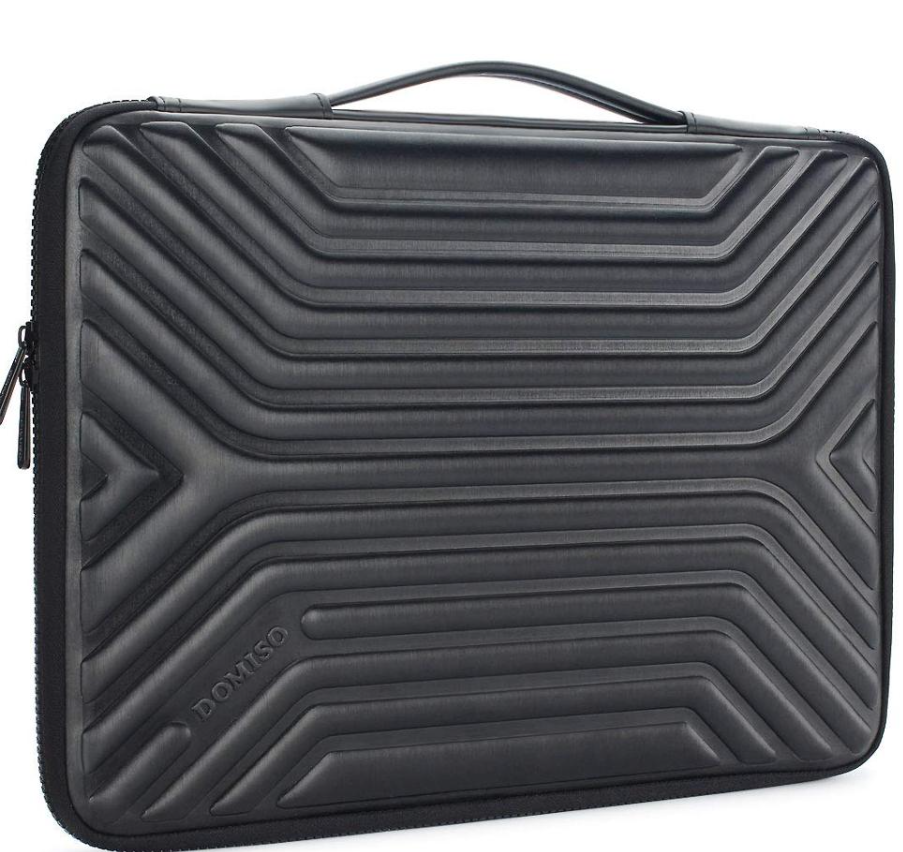Yes, hard shell cases provide substantial physical and cosmetic protection for laptops, though they have some limitations like limited shock absorption.
Table of Contents
Types of Laptop Cases
Soft Cases
Soft cases often come in the form of sleeves or messenger bags. Made from fabrics like neoprene, nylon, or leather, these cases offer basic protection against scratches and minor impacts. However, soft cases generally lack the rigid structure to protect your laptop against more severe impacts, such as a hard fall.
- Scratch Protection: The soft inner lining helps prevent scratches on the laptop surface.
- Lightweight: Soft cases are generally light and easy to carry.
- Limited Impact Resistance: They lack the solid frame to protect against severe physical impacts.
- Versatility: Often come with extra pockets for storing accessories like chargers and notebooks.
For more detailed information, you can visit the Soft Cases Wikipedia page.

Hard Shell Cases
Hard shell cases provide a more robust level of protection. Typically made from materials like polycarbonate or ABS plastic, these cases are designed to clip onto the laptop, forming a protective shell.
- Robust Protection: Offers better defense against physical impacts.
- Cosmetic Protection: Shields the laptop against scratches and scuffs.
- Accessibility: Designed to allow easy access to all ports and features without removing the case.
- Heat Management: Some hard shell cases come with built-in vents to manage heat dissipation.
For further reading, you can check the Hard Shell Cases Wikipedia page.
Backpacks with Laptop Compartments
Backpacks with dedicated laptop compartments offer a hands-free way to carry your device along with other belongings. These compartments often have padding to protect the laptop but lack the rigid structure of hard shell cases.
- Convenience: Allows you to carry a laptop along with other items like books, water bottles, and more.
- Comfort: Padded shoulder straps make it easier to carry heavy loads.
- Multi-Functional: These backpacks often include multiple compartments for various needs.
- Insufficient for Heavy Impact: While they offer some level of protection, it’s not comparable to hard shell cases in terms of impact resistance.
For more information, you can consult the Laptop Backpack Wikipedia page.
Advantages of Hard Shell Cases
Physical Protection
When you clip a hard shell case onto your laptop, you immediately enhance its resistance to physical damage. These cases, often made from sturdy materials like polycarbonate or ABS plastic, can handle impacts much better than soft cases or sleeves. They form a protective layer that shields the laptop from minor falls, bumps, and scrapes, reducing the risk of dents or structural damage.
For more insights, you might want to visit the Polycarbonate Wikipedia page.
Cosmetic Protection
Hard shell cases also act as a barrier against cosmetic wear and tear. Daily use can leave your laptop vulnerable to scratches, scuffs, and minor dings. A hard shell case prevents these cosmetic issues, keeping your device looking new for a longer period. This can be particularly important for maintaining the laptop’s resale value.
To learn more about cosmetic protection, check the Laptop Wikipedia page.
Easy Accessibility
One of the significant advantages of hard shell cases is that they’re designed to fit your laptop like a second skin. This means that you can easily access all ports, buttons, and features without having to remove the case. Whether you need to plug in a USB drive or connect to an external display, hard shell cases offer uninterrupted access to your laptop’s full functionality.
For further information on laptop ports and features, see the Computer Port Wikipedia page.
Customization Options
Finally, hard shell cases come in a variety of designs, textures, and colors, offering an excellent opportunity for customization. Whether you’re a professional wanting a sleek, unobtrusive look or a student looking to show off some personal flair, there’s likely a hard shell case to suit your style. Some brands even offer customizable hard shell cases where you can print your designs or logos, giving your laptop a unique appearance.
Disadvantages of Hard Shell Cases
Additional Weight
One downside of hard shell cases is the extra weight they add to your laptop. Even though many of these cases are made from relatively lightweight materials like polycarbonate, they can still add noticeable heft to your device. This might not be a concern for someone who primarily uses their laptop at a desk, but for travelers or students who carry their laptops around, the added weight could be inconvenient.
For more information on materials commonly used in hard shell cases, you might find the Polycarbonate Wikipedia page helpful.
Limited Shock Absorption
While hard shell cases offer excellent protection against minor impacts, they generally do not provide significant shock absorption. Unlike padded soft cases or backpacks with laptop compartments, hard shell cases lack cushioning material that can disperse the force of a severe impact. So, in the event of a major drop or collision, a hard shell case might not provide sufficient protection to prevent internal damage to the laptop.
For more about impact forces and materials that absorb them, check the Shock Absorber Wikipedia page.
Potential Overheating
Another issue to consider is that some hard shell cases can lead to overheating. Many cases do come with ventilation slots, but these might not align perfectly with your laptop’s cooling system. In extreme instances, this can lead to thermal throttling, where the laptop reduces its performance to manage heat.
To better understand how laptops cool themselves, visit the Computer Cooling Wikipedia page.
Cost
Hard shell cases can be relatively expensive, especially when compared to simple sleeves or soft cases. Premium cases from reputable brands can be quite an investment. The cost becomes a more significant factor if you’re someone who likes to update your case frequently or need to replace it due to wear and tear.

Comparing Hard Shell Cases to Other Protection Methods
Soft Cases vs. Hard Shell Cases
When comparing soft cases to hard shell cases, the first thing that comes to mind is the level of protection they offer. Soft cases, typically made from fabric materials like neoprene or leather, mainly protect against scratches and minor dings. On the other hand, hard shell cases made from materials like polycarbonate offer a higher degree of protection against physical impacts.
- Material: Soft cases use flexible materials, while hard shell cases use rigid plastics.
- Protection Level: Hard shell cases usually offer better protection against physical damage.
- Accessibility: Hard shell cases allow for easy access to all laptop ports and features.
- Weight: Soft cases are generally lighter but offer less protection.
For more in-depth information on materials used in soft cases, you can visit the Neoprene Wikipedia page.
Laptop Sleeves vs. Hard Shell Cases
Laptop sleeves are a subset of soft cases and usually offer the least amount of protection among the options. They’re good for preventing scratches but not much else. Hard shell cases offer a lot more when it comes to shielding your laptop from harm.
- Ease of Use: Sleeves require you to remove the laptop for use, whereas hard shell cases do not.
- Protection: Hard shell cases win in terms of protection from impacts.
- Aesthetics: Sleeves come in various designs but are often hidden when the laptop is in use, unlike hard shell cases.
For a deeper understanding of laptop sleeves, you can check out the Laptop Sleeve Wikipedia page.
Built-in Laptop Compartments in Backpacks vs. Hard Shell Cases
Backpacks with built-in laptop compartments offer the convenience of carrying multiple items along with your laptop. While these compartments often have some padding, they generally can’t match the protection level of a hard shell case.
- Multi-Functionality: Backpacks offer additional storage space for other items.
- Protection Level: Hard shell cases typically offer better protection against physical impacts.
- Convenience: Backpacks are hands-free and good for commuting but add significant weight.
Real-world Tests and Studies
Drop Tests
Drop tests are crucial for assessing the protective capabilities of hard shell cases. These tests involve deliberately dropping a laptop equipped with the case from various heights onto different surfaces such as concrete or hardwood floors. The goal is to observe if the hard shell case can prevent or minimize damage to the laptop. These tests often use high-speed cameras to capture the moment of impact and assess how well the case absorbs shock.
- Height Variability: Drop tests usually vary the height to simulate different real-world scenarios.
- Surface Types: The impact of the drop also depends on the type of surface.
- Damage Assessment: After the test, the laptop undergoes an examination to identify any signs of physical or internal damage.
For more information on testing methodologies, the Product Testing Wikipedia page may be of interest.
Temperature Tests
Temperature tests aim to understand how well the hard shell case can handle extremes of heat and cold. For instance, laptops encased in hard shell covers are placed in temperature-controlled chambers to assess if the case material warps or if it affects the laptop’s cooling system. These tests are vital because improper heat management can lead to reduced laptop performance.
- High-Temperature Scenarios: Testing in hot conditions can identify any warping of the case material.
- Low-Temperature Scenarios: The tests also check how well the case withstands cold conditions, as materials may become brittle.
For additional information on how temperature affects materials, you can check the Thermal Expansion Wikipedia page.

Longevity and Wear Tests
Longevity and wear tests evaluate how the hard shell case holds up to prolonged use. These tests involve subjecting the case to regular daily activities like opening and closing the laptop, plugging and unplugging cables, and sliding the laptop in and out of bags. The objective is to see how quickly the case shows signs of wear and tear, such as scratches, fading colors, or loosening fit.
- Daily Activities: The tests simulate frequent actions to understand the case’s durability.
- Time Span: These tests often span over months to even a year to gather comprehensive data.
- Wear Indicators: Signs like color fading, scratches, or cracks are looked for during the test period.






